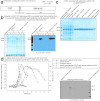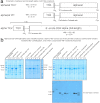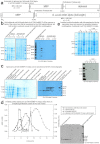Bacterial expression strategies for several Sus scrofa diacylglycerol kinase alpha constructs: solubility challenges
- PMID: 23558375
- PMCID: PMC3617429
- DOI: 10.1038/srep01609
Bacterial expression strategies for several Sus scrofa diacylglycerol kinase alpha constructs: solubility challenges
Abstract
We pursued several strategies for expressing either full-length Sus scrofa diacylglycerol kinase (DGK) alpha or the catalytic domain (alphacat) in Escherichia coli. Alphacat could be extracted, refolded, and purified from inclusion bodies, but when subjected to analytical gel filtration chromatography, it elutes in the void volume, in what we conclude are microscopic aggregates unsuitable for x-ray crystallography. Adding glutathione S-transferase, thioredoxin, or maltose binding protein as N-terminal fusion tags did not improve alphacat's solubility. Coexpressing with bacterial chaperones increased the yield of alphacat in the supernatant after high-speed centrifugation, but the protein still elutes in the void upon analytical gel filtration chromatography. We believe our work will be of interest to those interested in the structure of eukaryotic DGKs, so that they know which expression strategies have already been tried, as well as to those interested in protein folding and those interested in chaperone/target-protein interactions.
Figures






Similar articles
-
Fusion tags and chaperone co-expression modulate both the solubility and the inclusion body features of the recombinant CLIPB14 serine protease.J Biotechnol. 2005 Oct 17;120(1):2-10. doi: 10.1016/j.jbiotec.2005.04.028. Epub 2005 Jul 14. J Biotechnol. 2005. PMID: 16023240
-
Chaperone over-expression in Escherichia coli: apparent increased yields of soluble recombinant protein kinases are due mainly to soluble aggregates.Protein Expr Purif. 2009 Apr;64(2):185-93. doi: 10.1016/j.pep.2008.10.022. Epub 2008 Nov 11. Protein Expr Purif. 2009. PMID: 19038347
-
Arabidopsis AtDGK7, the smallest member of plant diacylglycerol kinases (DGKs), displays unique biochemical features and saturates at low substrate concentration: the DGK inhibitor R59022 differentially affects AtDGK2 and AtDGK7 activity in vitro and alters plant growth and development.J Biol Chem. 2005 Oct 14;280(41):34888-99. doi: 10.1074/jbc.M506859200. Epub 2005 Aug 4. J Biol Chem. 2005. PMID: 16081412
-
Prokaryotic diacylglycerol kinase and undecaprenol kinase.Annu Rev Biophys. 2012;41:81-101. doi: 10.1146/annurev-biophys-050511-102330. Epub 2011 Dec 20. Annu Rev Biophys. 2012. PMID: 22224599 Free PMC article. Review.
-
Properties and functions of diacylglycerol kinases.Cell Signal. 2000 Oct;12(9-10):595-605. doi: 10.1016/s0898-6568(00)00113-3. Cell Signal. 2000. PMID: 11080611 Review.
Cited by
-
Expression and purification of human diacylglycerol kinase α from baculovirus-infected insect cells for structural studies.PeerJ. 2018 Aug 10;6:e5449. doi: 10.7717/peerj.5449. eCollection 2018. PeerJ. 2018. PMID: 30128205 Free PMC article.
-
Elusive structure of mammalian DGKs.Adv Biol Regul. 2022 Jan;83:100847. doi: 10.1016/j.jbior.2021.100847. Epub 2021 Dec 2. Adv Biol Regul. 2022. PMID: 34922895 Free PMC article. Review.
References
-
- Takeishi Y., Goto K. & Kubota I. Role of diacylglycerol kinase in cellular regulatory processes: a new regulator for cardiomyocyte hypertrophy. Pharmacol. Ther. 115, 352–359 (2007). - PubMed
-
- Ali H. et al. Selective translocation of diacylglycerol kinase zeta in hippocampal neurons under transient forebrain ischemia. Neurosci. Lett. 372, 190–195 (2004). - PubMed
-
- Kanoh H. & Ohno K. Partial purification and properties of diacylglycerol kinase from rat liver cytosol. Arch. Biochem. Biophys. 209, 266–275 (1981). - PubMed
Publication types
MeSH terms
Substances
Grants and funding
LinkOut - more resources
Full Text Sources
Other Literature Sources

